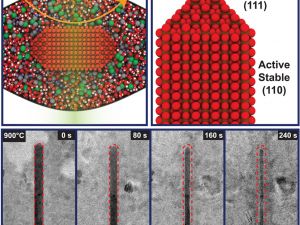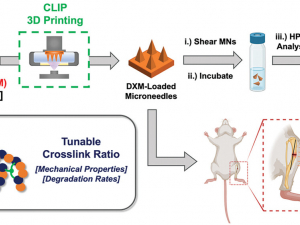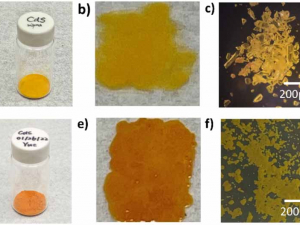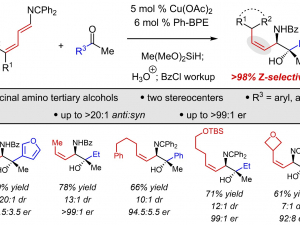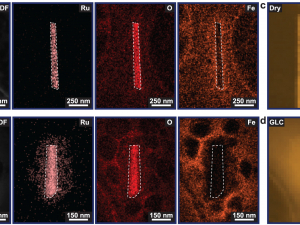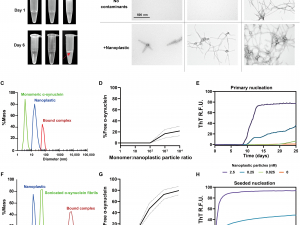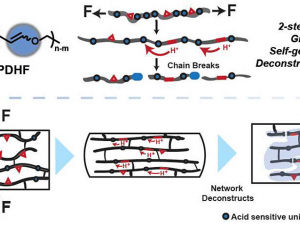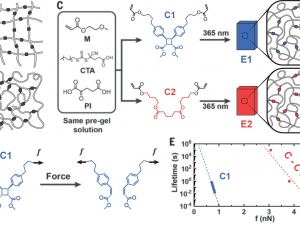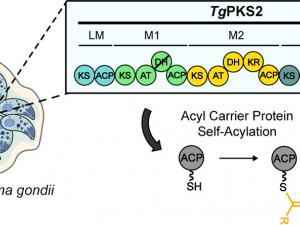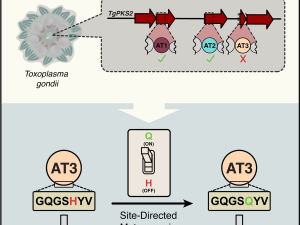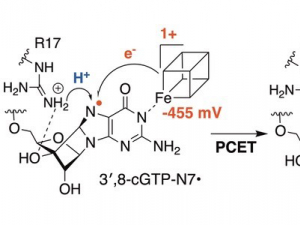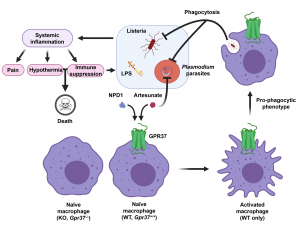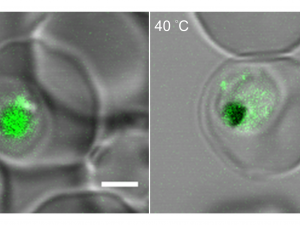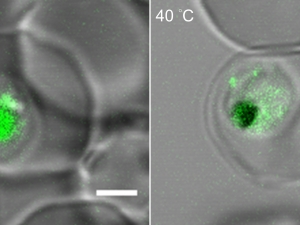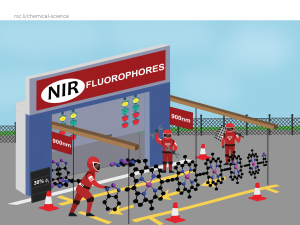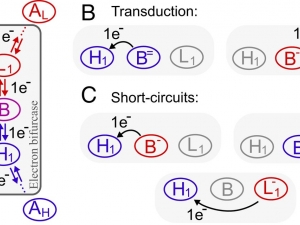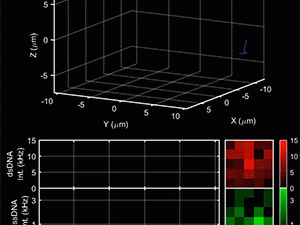Researchers in the Hong Lab, in collaboration with the Lee Lab (Department of Biochemistry) and the Ji Lab (Department of Anesthesiology), have recently published exciting new findings in Nature Communications on the development of a novel non-opioid pain medication. This research addresses the critical need for safer and more effective pain management strategies in the face of the ongoing opioid crisis. The team focused on the equilibrative nucleoside transporter subtype 1 (ENT1), a protein that regulates levels… read more about Promising Therapeutic Target for Pain Relief and Developing Non-addictive Pain Medications »
Researchers in the Hong Lab, in collaboration with the Heitman Lab (Department of Molecular Genetics and Microbiology) and the Steinbach and Juvvadi Labs (University of Arkansas), have announced a significant advancement in the fight against fungal infections. They have developed a series of new antifungal drugs that show potent activity against harmful fungi while minimizing effects on the human immune system. Fungal infections pose a significant global health threat, but there are limited treatment options available.… read more about Revolutionizing the Treatment of Fungal Infections Through Modified Natural Products »
The rise of multidrug-resistant Gram-negative bacteria is a serious threat to public health. To combat these dangerous pathogens, we urgently need new antibiotics that work differently than existing ones. One promising approach is to target lipid A biosynthesis, a critical process for maintaining the integrity of the bacterial cell wall and bacterial survival. Researchers in the Hong Lab, in collaboration with the Zhou (Department of Biochemistry) and Yang (Department of Chemistry) Labs, have developed promising… read more about Combatting Drug-resistant Gram-negative Bacteria »
Professor Patrick Charbonneau has taken his knowledge of crystallization outside of the research lab and in to French-Canadian history. Charbonneau, an instructor of Chemistry 130L (The Chemistry and Physics of Cooking) has been using the example of fudge in his classes for several years to illustrate the polycrystalline structure of materials. It is when the time comes to find a source to explain the origin of the recipe that he runs into a problem: the available sources are "a bit of a mess," research hypotheses that are… read more about Crystallization Fascination Leads to History Revisited »
Hydrogen has the potential to be a great alternative to fossil fuels, specially “green hydrogen” which is produced by using electricity from renewable sources (e.g., wind, solar or hydroelectric) in devices called electrolyzers which split water into hydrogen and oxygen.Corrosion of catalysts inside electrolyzers is one of the main issues with the production of “green hydrogen” that prevents the adoption of electrolyzers at a global scale.The Moreno-Hernandez Laboratory focuses on understanding how the structure of these… read more about Moreno-Hernandez Lab highlights the importance of understanding nanoscale dynamic restructuring »
Professor of Chemistry Ben Wiley was honored with the Cleantech Research Innovation Award at the Research Triangle Cleantech Cluster (RTCC)’s annual awards ceremony.The Cleantech Research Innovation Award recognizes an individual or team from industry or within an institution of higher education that is pursuing a research-based solution to a pressing cleantech challenge. Wiley’s work is focused on the reduction of industrial carbon emissions through the production of green hydrogen. Carbon emissions from the… read more about Ben Wiley Receives Clean Energy Research Innovation Award »
The Becker Lab is expanding the material properties of 3D-printed poly (propylene fumarate-co-propylene succinate) copolyesters and their use in drug delivery applications. In their recent work, "Controlled Transdermal Delivery of Dexamethasone for Pain Management via Photochemically 3D-Printed Bioresorbable Microneedle Arrays", Becker lab members are fabricating poly(propylene fumarate-co-propylene succinate) oligomers into DXM-loaded, bioresorbable MAPs via continuous… read more about Becker Lab Expanding the Material Properties of 3D-printed Polyesters for Use in Drug Delivery Applications »
The Warren Lab's recent use of pump-probe microscopy for effective art restoration was featured in Laser Focus World. The lab built upon their mode-locked laser systems from the early 2000's, using pump-probe microscopy—a nonlinear optical imaging technique used to study chemical reactions. The lab uses ultrafast laser pulses of near-infrared (IR) light to allow for the identification of chemical compounds present in a paint pigment sample without invasive means. The team is now working… read more about Warren Lab's Use of Pump-probe Microscopy for Art Restoration Featured in Laser Focus World »
The Malcolmson lab has discovered a reductive coupling of azatrienes and ketones for the Z-selective synthesis of allylic 1,2-amino tertiary alcohols. The strategy, developed by a team that was spearheaded by graduate student Jiaqi Zhu, provides an aminoallylation approach to this valuable pharmacophore that greatly expands upon the chemical space that is accessible for this moiety. The reaction is a rare example of a catalytic carbonyl allylation that forms a Z-alkene and two stereogenic centers and is… read more about Malcolmson Lab Discovers Catalytic Z-Selective Ketone Aminoallylations to Prepare Vicinal Amino Tertiary Alcohols »
The Moreno-Hernandez Lab has their first Duke publication! In a recent JACS article, the Lab published findings that highlight the importance of nanoscale heterogeneity in determining macroscale properties such as electrocatalyst stability. Their efforts provide a characterization methodology that can be integrated into next-generation electrocatalyst discovery efforts. Check out their work, "Dissolution Heterogeneity Observed in Anisotropic Ruthenium Dioxide Nanocrystals via Liquid-… read more about Moreno-Hernandez Lab Finds the Importance of Nanoscale Heterogeneity »
The Haas Lab, with undergraduate researcher Abigail Strausbaugh Hjelmstad, facilitate a comparison of Cu(I) binding to six N-truncated amyloid beta (Aβ) model peptides and contribute to the understanding of the role of Aβ peptides as copper chelators in healthy and diseased brains in their recent publication, "Investigating Cu(I) binding to model peptides of N-terminal Aβ isoforms", available in the Journal of Inorganic Biochemistry. Learn more about their findings here! read more about Haas Lab Investigating Cu(I) binding to model peptides »
Metallic carbon nanotubes are one-dimensional tubular structures made up of hexagonally bonded sp2 carbon atoms. The Therien Lab has shown that by wrapping a metallic nanotube surface with rigid polymers, a semiconductor can be realized. This strategy contrasts with approaches that regulate electronic structural properties of bulk-phase materials which rely on altering the nature of covalent bonding. Reversible non-covalent polymer wrapping of metallic carbon nanotubes interconverts metallic and… read more about Therien Lab Realizes Low Band Gap One-dimensional Materials by Design »
Of the fastest growing neurological disorders in the world, Parkinson’s disease is pathologically defined by the accumulation of the protein α-synuclein in vulnerable neurons in the brain. Prolonged exposure to environmental challenges of largely unknown origins are suspected as principal driving factors for disease risk and progression. The increase in polystyrene nanoplastics in the environment from single-use plastics, recent detection of polystyrene contaminants in blood, and reports of anionic polystyrene… read more about Do the toxins of anionic nanoplastics have a possible role in Parkinson’s disease risk and progression? »
Work from the Craig lab shows how embedded mechanophores can be used to transduce mechanical force into triggered polymer network deconstruction. The paper, "Mechanically Triggered Polymer Deconstruction through Mechanoacid Generation and Catalytic Enol Ether Hydrolysis," is available at J. Am. Chem. Soc. read more about Craig Lab Continues to Expand the Utility of Responsive Polymers »
The Malcolmson lab has developed a three component carboamination of dienes utilizing aliphatic and aryl amines in conjunction with alkenyl electrophiles. Two different Pd-based catalysts allow for regiodivergent introduction of the amine reagent. The multicomponent coupling, together with the regiodivergence, enables the rapid production of a library of small molecule building blocks to facilitate drug discovery. Mechanistic experiments suggest the origin of regioselectivity with both catalysts, including a key pi-stacking… read more about Malcolmson Lab Develops Catalytic Three Component Regiodivergent Reactions to Prepare Allylic Alkyl Amines »
A study by the Craig lab and collaborators provides a blueprint for rewriting historical performance rules for materials made from polymer networks. Adding a small fraction of reactive groups in the right places within conventional networks can make the materials about 10 times more difficult to tear, and systematic studies uncover a physical picture at the heart of the phenomenon. Read here for more information: https://www.science.org/doi/full/10.1126/science.adg3229 read more about Embedding reactive bonds leads to less breakable materials »
How do parasites make natural products? A new study by the Derbyshire lab resolved a polyketide synthase present in Toxoplasma gondii and observed an unexpected self-acylation activity with acyl carrier proteins within this system. Their findings suggest a potential regulatory mechanism and may help identify the metabolite(s) being made by the parasite in future studies. You can read more about their work in a recent ACS Chemical Biology issue, available here. read more about Derbyshire Lab May Help Identify the Metabolite(s) Being Made by Parasites »
The Derbyshire lab has recently published a research article in Cell iScience investigating the activity of acyltransferase (AT) domains in a polyketide synthase from the apicomplexan parasite Toxoplasma gondii. Their work identifies a single amino acid in these domains responsible for protein activity which was able to be controlled through mutational studies, effectively serving as an "on-off" switch for AT activity. Read more about their exciting work here! read more about Derbyshire Lab investigates the activity of AT domains from the parasite Toxoplasma gondii »
COVID19 cases are receding in some parts of the world but surging in other parts, especially those with limited access to vaccines, ultimately making the entire world population a vulnerable prey of the constantly emerging new variants. In a recent Science Advances publication, Martina Zafferani of the Hargrove Lab and collaborators tackled the problem by developing antivirals that take direct aim at SARS-CoV-2 RNA structure. They identified amiloride derivatives that can… read more about Coronavirus's Tangled Strands of RNA Could Offer New Ways to Treat People Who Get Infected »
A collaboration between the Yokoyama and Yang Labs has led to a publication of their latest work on the catalytic mechanism of MoaA radical SAM cyclase in molybdenum cofactor biosynthesis. In this work, combined efforts using electrochemistry, EPR spectroscopy, and DFT calculation provided evidence that the reduction of the aminyl radical intermediate proceeds by a proton-coupled electron transfer (PCET) with a 4Fe-4S cluster as an electron donor. The EPR also revealed an electronic coupling between GTP and… read more about Yokoyama and Yang Labs collaborate to find insights into the radical quenching step of radical SAM enzyme catalysis »
Dr. Pengfei Zhou of the Malcolmson Lab, in collaboration with former Malcolmson Lab postdoc Dr. Xinxin Shao, now an assistant professor at Hangzhou Normal University, have developed a new reagent class, 2-azatrienes, that enables the diastereodivergent and enantioselective synthesis of allylic 1,2-diamines through copper-catalyzed reductive couplings with imines. Both syn- and anti-diamines are key fragments in a number of potent bioactive molecules and are each formed selectively in their respective CuH-… read more about Malcolmson Lab Develops a New Reagent for Diastereodivergent and Enantioselective Synthesis of Allylic Amines »
Recent work from the Ji (Department of Anesthesiology at Duke) and Derbyshire labs has led to the unexpected discovery that artesunate, a front-line antimalarial, confers protection against infection-induced sepsis and pain-like behavior in mice. Artesunate has been used for decades in the clinic, and while its potent anti-plasmodium activity has been widely studied, little is known about its interactions with host cells. While studying the possible role of the human orphan GPCR GPR37, they found that GPR37 agonists may… read more about Derbyshire Lab Making Strides Toward Treating Malaria »
A recent collaborative effort between the Derbyshire lab at Duke and Prof. Jacquin Niles’ lab at the Massachusetts Institute of Technology discovered a mechanism that helps Plasmodium falciparum parasites survive hostile thermal conditions recapitulating malaria fever. The study shows that P. falciparum, the deadliest of the human malaria parasites, uses the lipid PI(3)P and heat shock protein 70 to stabilize the parasite’s digestive vacuole under heat stress. Read more about their discovery… read more about Derbyshire Lab Illuminates How Malaria Parasites Withstand Feverish Temperatures »
The Therien lab studied highly conjugated porphyrin arrays and incorporated proquinoidal linkers— small molecules that have closely aligned LUMO energy levels to the parent porphyrins arrays. They found that capping porphyrin arrays with proquinoidal moleculesarray preserves and enhances conjugation, resulting in a red-shifted emission, while also increasing the radiative rate constant, making these systems uniquely good NIR fluorophores. Read about this excellent work by Erin, Dr. Peng Zhang and former… read more about Highly Conjugated NIR-absorbing Fluorophores Display Extraordinary Absolute Fluorescence Quantum Yield Values »
A paper just published by the Beratan Lab resolves a long standing puzzle in molecular bioenergetics. A class of reactions that lies at the core of biological energy conversion - and underpins Mitchell’s Nobel Prize winning chemiosmotic hypothesis - had remained enigmatic for nearly 50 years. Cursory analysis of these reactions suggested that they should “short circuit” and dissipate energy, rather than transduce it. Jon Yuly, a Physics graduate student at Duke, working with Profs. Beratan and Zhang in… read more about One Universal Free-energy Landscape Supports Efficient Electron Bifurcation Reactions »
The Warren Lab has demonstrated a simple optical measurement method to evaluate the efficacy of masks to reduce the transmission of respiratory droplets during regular speech. In proof-of-principle studies, they compared a variety of commonly available mask types and observed that some mask types approach the performance of standard surgical masks, while some mask alternatives, such as neck fleece or bandanas, offer very little protection. Read about Dr. Fischer's findings in a recent issue of Science Advances… read more about A Box, a Laser, a Lens, and a Cell Phone: Visual Proof that Face Masks Work in the COVID Fight »
Very commonly, molecules don't evolve simply under quantum mechanics-the evolution is interrupted by exchange or reactions. The study of this kind of coherent evolution in dynamic systems is at the forefront of many disciplines, but has been prominent in magnetic resonance for more than 50 years. However, the arguments that led to the theoretical formalism were motivated under incorrect assumptions. The Warren lab has recently reported on a complete re-interrogation of this problem, and has presented a corrected theory that… read more about Warren Lab Completely Reassess the Foundations of Chemical Exchange Models »
Measuring the behavior of single molecules enables the discovery of states and dynamics obscured by bulk measurements. However, molecules in solution rapidly diffuse in three dimensions, precluding long-duration and high-temporal resolution measurement. In a new breakthrough, Dr. Shangguo Hou of the Welsher Lab has developed 3D single-molecule active real-time tracking (3D-SMART), which can “lock-on” to freely diffusing single molecules in solution for up to minutes at a time! This new single molecule tracking can be… read more about Untethering Single Molecule Spectroscopy with 3D-SMART »
The Derbyshire lab is examining biosynthetic gene clusters of bacteria isolated from the gut of Anopheles mosquitoes, the main vector for the transmission of malaria. Through a bioinformatic analysis, iron-binding siderophores were abundant within microbiome bacteria. After testing the metabolites, two siderophores disrupt mosquito reproduction and also inhibit blood and liver forms of the malaria parasite. Overall, this study sets a foundation for new vector control strategies to inhibit the transmission… read more about Derbyshire Lab Sets Foundation for Inhibiting Transmission of Malaria Parasite »





